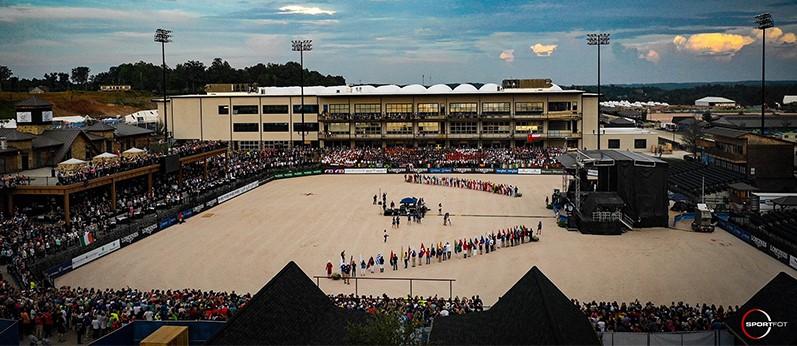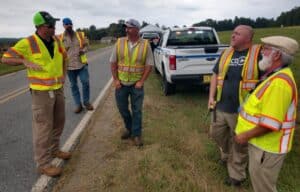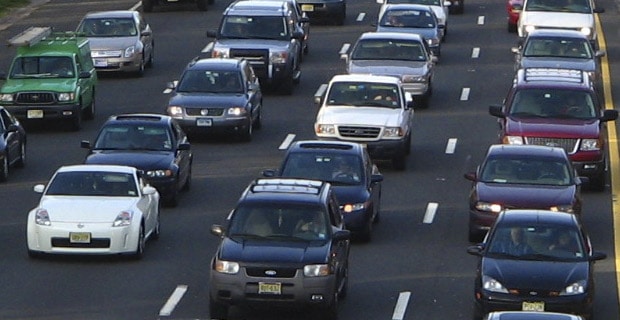


After 18 months of planning, and a two month weather delay in April, we’re excited to see the 2018 FEI World Equestrian Games get underway! In the top photo, Opening Ceremonies of the FEI World Equestrian Games on Tuesday, Sept. 11. In the above left photo, JMTE Transportation Safety Engineer Jim Kellenberger, right, and Abe Zeiger, of Branz Technologies, left, discuss traffic planning with members of the NCDOT Division 14 Flagger/Spotter crew. Above right, JMTE Planning Technician Candace Hladick, right, stands with TIEC’s Molly Oakman.
Keeping one eye on Tryon, the other on Florence
After more than a year of hard work and planning, folks at JMTE have been looking forward to the arrival this week of the 2018 FEI World Equestrian Games (WEG) in neighboring Tryon, NC. But as officials for the games and the Tryon International Equestrian Center (TIEC) prepared for the opening ceremony this past Tuesday, Sept. 11, they were also keeping a close eye on Hurricane Florence and the possibility that heavy weather could affect the games.
At a press conference Tuesday afternoon, WEG and TIEC officials said they were ready if Florence takes a turn toward western North Carolina. Officials stated that robust contingency plans were in place for personnel and horses in the event of severe weather conditions. This includes 1,288 permanent stalls onsite and all barns are built in conformance with international business codes.
The National Weather Service has set up an office at TIEC, and is providing game officials with updates every six hours, but the weather hasn’t changed any scheduled activities yet. So, if you make it out to a WEG events over the next two weeks, have a great time and take a good look around. You’ll see evidence of JMTE’s work most everywhere.
It has been a truly exciting opportunity to work with the WEG and TIEC to provided mapping and design services throughout the process of planning for and carrying out events. This has included developing operational plans for the games, along with maps for all planned expansions and game layouts, maps to reflect the fields of play, and geospatial data collection and mapping of existing cross-country fields and paths.
Planning Technician Candace Hladick took the lead on the project, which has also included serving as a liaison between TIEC and the North and South Carolina Departments of Transportation for on-site traffic, roadway and signage matters and we’ve provided transportation planning for everything from parking lot layouts to spectator busing, pedestrian movement and event traffic control plans.
In addition, we’ve worked with TIEC staff to develop integrated plans for the safe, efficient movement of horses, people and motorized vehicles throughout the venue. In recent weeks, JMTE has provided training to TIEC staff and others regarding traffic management during events and within work zones (e.g., “flagger” and “work zone supervisor” training).
The World Equestrian Games run through Sunday, Sept. 23. If Florence doesn’t become a factor, the daily events are expected to draw an average daily attendance of 40,000 to 50,000 people from all over the world. NBC Sports is providing nearly 65 hours of television coverage from the TIEC, including 57 hours of live coverage.
If the hurricane does come this way, it won’t be the first time that the TIEC has had to care for a lot of horses, due to threatening weather. TIEC served as a refuge for horses from five states in advance of Hurricane Irma last year. To stay updated on WEG events and any affects from Hurricane Florence, please CLICK HERE.
We hope to see you at the games. For tickets and other information, please click the following links:
- Tickets – https://tryon2018.com/tickets/event-tickets
- Frequently Asked Questions – https://tryon2018.com/page/fei-world-equestrian-games-tryon-2018-faq
- FEI World Equestrian Games website – https://tryon2018.com/
If you have to travel this week, stay informed
Will you be traveling around the Carolinas as Hurricane Florence makes landfall? Do you have family or friends who might be affected by the storm.? JMTE urges you to stay informed by checking out the travel information available on the North and South Carolina Dept. of Transportation websites. Here are the links:
- NCDOT Travel Information Management System – Put in the route or region you’re interested in and get reliable information on any problems created by Florence. There’s also links to tons of helpful information about driving safety and other issues during weather events.
- SCDOT Hurricane Resources – Stay current on any I-26 lane reversals, road conditions and storms reports, among other things.
Don’t forget if you have a roadway emergency in either state, you can reach state highway patrol officers or emergency responders by dialing “*HP” on your cell phone. Be safe out there!
JMTE welcomes new staffer Thompsen

Transportation Specialist William Thompsen brings with him 33 years of experience as a planning professional. His responsibilities include conducting a wide array of traffic and transportation-related studies, such as traffic impact, corridor, feasibility and parking studies; conducting transportation assessments for signs, pavement and sidewalk conditions, and traffic signal operations.
Will specializes in conducting multi-modal transportation studies and his expertise includes travel demand modeling, traffic impact studies, freight studies, parking studies, corridor planning, traffic operational analyses, land use studies, and public involvement.
Will moved to western North Carolina from Minneapolis, MN after serving in various professional positions from 2001-2014, including Senior Project Planner for CH2M Hill, Inc., Senior Transportation Planner/Project Manager with Iteris/Meyer, Mohaddes Associates and HDR, Inc.
Which nations have the most cars?
Since visitors from all over the world are expected to attend the World Equestrian Games these next two weeks, and since we’re a transportation and traffic firm, we thought it might be fun to compare the number of cars in various parts of the world. (Source: Green Car Reports; 2008 statistics):
- USA – 765 cars (per 1,000 people)
- Europe – 472 cars
- China – 10 cars
- Africa – less than 5 cars

